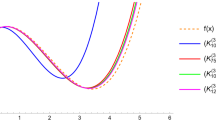Abstract
This paper develops bounds on the rate of decay of powers of Markov kernels on finite state spaces. These are combined with eigenvalue estimates to give good bounds on the rate of convergence to stationarity for finite Markov chains whose underlying graph has moderate volume growth. Roughly, for such chains, order (diameter) steps are necessary and suffice to reach stationarity. We consider local Poincaré inequalities and use them to prove Nash inequalities. These are bounds onl 2-norms in terms of Dirichlet forms andl 1-norms which yield decay rates for iterates of the kernel. This method is adapted from arguments developed by a number of authors in the context of partial differential equations and, later, in the study of random walks on infinite graphs. The main results do not require reversibility.
Similar content being viewed by others
References
Bakry, D., Coulhon, T., Ledoux, M., and Saloff-Coste, L. (1995). Sobolev inequalities in disguise. Université Paul Sabtier, Toulouse.Stat. et. Prob., Preprint.
Carlen, E., Kusuoka, S., and Stroock, D. (1987). Upper bounds for symmetric Markov transition functions.Ann. Inst. H. Poincaré, Prob. Stat. 23, 245–287.
Chung, F., Diaconis, P., and Graham, R. (1987). A random walk problem arising in random number generation.Ann. Prob. 15, 1148–1165.
Coulhon, T., and Saloff-Coste, L. (1990a). Puissance d'un opérateur regularisant.Ann. Inst. H. Poincaré, Prob. Stat. 26, 419–436.
Coulhon, T., and Saloff-Coste, L. (1990b). Marches aléatoires non-symétriques sur les groupes unimodulaires.C. R. Acad. Sci. Paris, Série I,310, 627–630.
Coulhon, T., and Saloff-Coste, L. (1993). Isopérimétrie sur les groupes et les variétés.Rev. Mat. Iberoamericana,9, 293–314.
Diaconis, P. (1982).Applications of Non-Commutative Fourier Analysis to Probability Problems. Springer L.N.M.1362, 51–100.
Diaconis, P. (1986).Group Representations in Probability and Statistics. IMS, Hayward.
Diaconis, P., and Saloff-Coste, L. (1933a). Comparison theorems for reversible Markov chains.Ann. Appl. Prob. 3, 696–730.
Diaconis, P., and Saloff-Coste, L. (1993b). Comparison techniques for random walk on finite groups.Ann. Prob. 21, 2131–2156.
Diaconis, P., and Saloff-Coste, L. (1994a). Moderate growth and random walk on finite groups.Geom. and Funct. Anal. 4, 1–34.
Diaconis, P., and Saloff-Coste, L. (1995). An application of Harnack inequalities to random walk on nilpotent quotients. Actes du Colloque en l'honneur de J. P. Kahane.J. Fourier Anal. Appl. (special Kahane issue) 189–208.
Diaconis, P., and Saloff-Coste, L. (1992). Logarithmic Sobolev inequalities and finite Markov chains.Annals Apol. Prob. (to appear).
Diaconis, P., and Saloff-Coste, L. (1994c). Geometric bounds on character ratios and symmetric functions. Manuscript.
Diaconis, P., and Shashahani, M. (1981). Generating a random permutation with random transpositions.Z. Wahrsch. Verw. Geb. 57, 159–179.
Diaconis, P., and Stroock, D. (1991). Geometric bounds for eigenvalues for Markov chains.Ann. Appl. Prob. 1, 36–61.
Diaconis, P., and Sturmfels, B. (1993). Algebraic algorithms for sampling from conditional distributions.Ann. Stat. (to appear).
Dyer, M., and Frieze, A. (1991). Computing the volume of convex bodies: a case where randomness proveably helps. In Bollobàs, B. (ed.),Probabilistic Combinatorics and Its Applications, Proc. Symp. Appl. Math. 44, 123–170.
Fabes, E. (1993). Gaussian upper bounds on fundamental solutions of parabolic equations: the method of Nash. InDirichlet Forms, L.N.M. Springer, p. 163.
Feller, W. (1968).An Introduction to Probability Theory and Its Applications, Vol. I, Third Edition J. Wiley and Sons.
Fill, J. (1991). Eigenvalue bounds on convergence to stationarity for nonreveresible Markov chains with an application to the exclusion process.Ann. Appl. Prob. 1, 62–87.
Gohberg, I., and Krein, I. (1969). Introduction to the theory of linear non-selfadjoint operators. Providence.Amer. Math. Soc.
Hildebrand, M. (1992). Generating random elements in SL n (F q ) by random transvections.J. Alg. Combinatorics 1, 133–150.
Horn, R., and Johnson, C. (1990).Topics in Matrix Analysis. Cambridge University Press.
Jerrum, M., and Sinclair, A. (1989). Approximating the permanent.SIAM J. Comp. 18, 1149–1178.
Lawler, G., and Sokal, A. (1988). Bounds on theL 2 spectrum for Markov chains and Markov processes: A generalization of Cheeger's inequality.Trans. Amer. Math. Soc. 309, 557–580.
Lovasz, L., and Simonovits, M. (1990). Random walks in a convex body and an improved volume algorithm.Random Struct. and Algo. 4, 359–412.
Mihail, E. (1989). Combinatorial aspects of expanders. Ph.D. dissertation, Department Computer Sciences, Harvard University.
Nash, J. (1958). Continuity of solutions of parabolic and elliptic equations.Amer. J. Math. 80, 931–954.
Marshall, A., and Olkin, I. (1979).Inequalities: The Theory of Majorization and Its Applications. Academic Press, New York.
Robinson, D. (1991).Elliptic Operators on Lie Groups. Oxford University Press.
Sinclair, A., and Jerrum, M. (1989). Approximate counting, uniform generation and rapidly mixing Markov chains.Inform. and Comput. 82, 93–133.
Sinclair, A. (1993).Algorithms for Random Generation and Counting: A Markov Chain Approach. Birkhäuser, Boston.
Stein, E., and Weiss, G. (1971).Introduction to Fourier Analysis on Euclidean Spaces. Princeton University Press.
Varopoulos, N. (1984). Une généralisation du théorème de Hardy-Littlewood-Sobolev pour les espaces de Dirichlet.C. R. Acad. Sc. Paris, Série I,299, 651–654.
Varopoulos, N. (1985). Isoperimetric inequalities and Markov chains.J. Funct. Anal. 63, 215–239.
Varopoulos, N., Saloff-Coste, L., and Coulhon, T. (1993).Analysis and Geometry on Groups. Cambridge University Press.
Author information
Authors and Affiliations
Rights and permissions
About this article
Cite this article
Diaconis, P., Saloff-Coste, L. Nash inequalities for finite Markov chains. J Theor Probab 9, 459–510 (1996). https://doi.org/10.1007/BF02214660
Received:
Revised:
Issue Date:
DOI: https://doi.org/10.1007/BF02214660



